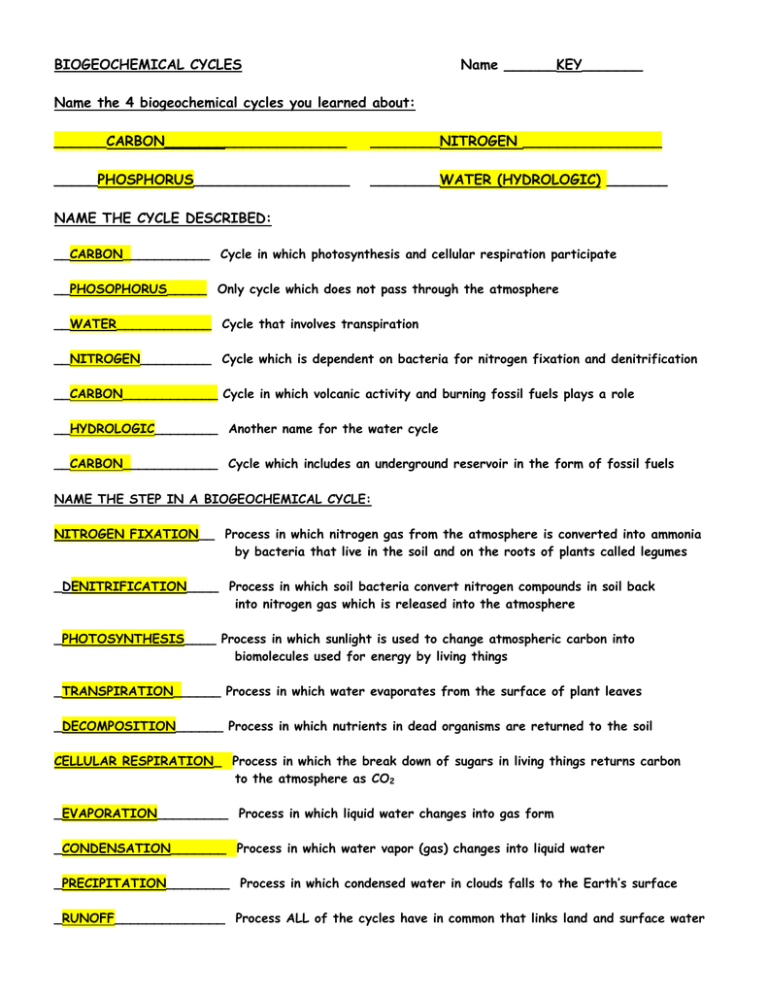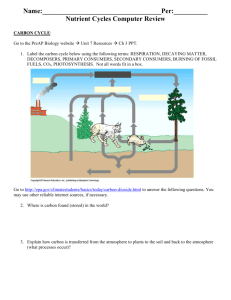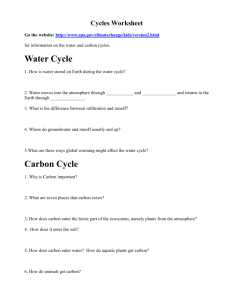BIOGEOCHEMICAL CYCLES Name ______KEY_______ Name the 4 biogeochemical cycles you learned about:
advertisement

BIOGEOCHEMICAL CYCLES Name ______KEY_______ Name the 4 biogeochemical cycles you learned about: ______CARBON_____________________ ________NITROGEN ________________ _____PHOSPHORUS__________________ ________WATER (HYDROLOGIC) _______ NAME THE CYCLE DESCRIBED: __CARBON___________ Cycle in which photosynthesis and cellular respiration participate __PHOSOPHORUS_____ Only cycle which does not pass through the atmosphere __WATER____________ Cycle that involves transpiration __NITROGEN_________ Cycle which is dependent on bacteria for nitrogen fixation and denitrification __CARBON____________ Cycle in which volcanic activity and burning fossil fuels plays a role __HYDROLOGIC________ Another name for the water cycle __CARBON____________ Cycle which includes an underground reservoir in the form of fossil fuels NAME THE STEP IN A BIOGEOCHEMICAL CYCLE: NITROGEN FIXATION__ Process in which nitrogen gas from the atmosphere is converted into ammonia by bacteria that live in the soil and on the roots of plants called legumes _DENITRIFICATION____ Process in which soil bacteria convert nitrogen compounds in soil back into nitrogen gas which is released into the atmosphere _PHOTOSYNTHESIS____ Process in which sunlight is used to change atmospheric carbon into biomolecules used for energy by living things _TRANSPIRATION______ Process in which water evaporates from the surface of plant leaves _DECOMPOSITION______ Process in which nutrients in dead organisms are returned to the soil CELLULAR RESPIRATION_ Process in which the break down of sugars in living things returns carbon to the atmosphere as CO2 _EVAPORATION_________ Process in which liquid water changes into gas form _CONDENSATION_______ Process in which water vapor (gas) changes into liquid water _PRECIPITATION________ Process in which condensed water in clouds falls to the Earth’s surface _RUNOFF______________ Process ALL of the cycles have in common that links land and surface water Mention which group of organisms that all the cycles have in common which keeps matter cycling between living (organic) and nonliving (inorganic) parts of the ecosystem. __DECOMPOSERS____ Tell 2 human activities by which carbon can enter the atmosphere as CO2 during the carbon cycle ___BURNING FOSSIL FUELS, CELLULAR RESPIRATION, __________ Name 2 NON-human activities by which carbon can enter the atmosphere or oceans during the carbon cycle. VOLCANIC ACTIVITY, DECOMPOSITION, DISSOLVING IN WATER Tell one way carbon leaves the atmosphere during the carbon cycle. ___PHOTOSYNTHESIS, DISSOLVING IN WATER, Tell 2 ways water enters the atmosphere in the water cycle EVAPORATION AND TRANSPIRATION Tell something humans do to return nitrogen to the soil for the nitrogen cycle. __DECOMPOSITION, FERTILIZER USE_______ Although almost 80% of the atmosphere is made up of nitrogen gas, most living things don’t have the enzymes necessary to use nitrogen directly from the atmosphere. Tell how we get the nitrogen we need to make proteins and DNA if we can’t get it from breathing. We don’t have the enzymes necessary to remove nitrogen from the atmosphere; we get our nitrogen from the FOOD WE EAT.






